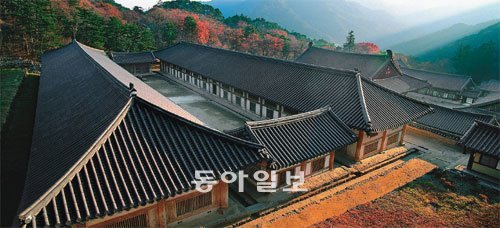
The United Nations Educational, Scientific and Cultural Organization (UNESCO) has been designating mankind’s cultural and natural legacies as “World Heritage” since 1972 to preserve assets considered to be of outstanding value to humanity. The designation applies to “territorial” assets, meaning those that cannot be moved, such as buildings or geographical features, rather than works of art. As of 2010, 911 assets in 151 countries have been named World Heritage; Korea is the proud possessor of 10.
□1 Tripitaka Depository in Haeinsa Temple
In Haeinsa Temple in Korea’s deep south stand two elongated wooden buildings. These buildings, dating from the 14th century, stand alongside one another on a north-south axis and appear outwardly simple to the eye. However, the scientific brilliance of their design and their harmony with nature have preserved the Tripitaka Koreana, the most complete collection of Buddhist texts in the world, engraved upon 80,000 woodblocks, in perfect condition for more than 500 years.
□2 Jongmyo Shrine
Jongmyo, in central Seoul, is a shrine for the ancestral worship of deceased kings and queens of the Joseon Dynasty (1392-1910); as such, it embodies the most refined and stately architecture of the era. Because it is a place for Confucian ancestral rites, the architecture is free of any ornamentation; it is grand but austere.
The music and dance for royal ancestral rites have also been passed down and continue to take place at Jongmyo, which has existed in its present form since the 16th century. Both the hardware and software of Jongmyo are recognized by UNESCO.
□3 Seokguram Grotto and Bulguksa Temple

□4 Changdeokgung Palace
Central Seoul’s Changdeokgung - “The Palace of Prosperous Virtue” - is a Joseon palace built in 1405. It exhibits an outstanding harmony with nature; its buildings stand on hills to preserve the area’s natural topography. Its pastoral Secret Garden was the resting place for royalty and features ornamental ponds, pavilions and trees that are hundreds of years old.
Changdeokgung was the favorite palace of the monarchs of Joseon - a dynasty that did not stint on palace building. The last, elderly remnants of the dynasty, which fell when Japan seized control of Korea in 1910, resided in this palace until the 1960s.
□5 Hwaseong Fortress
□6 Gyeongju Historic Areas
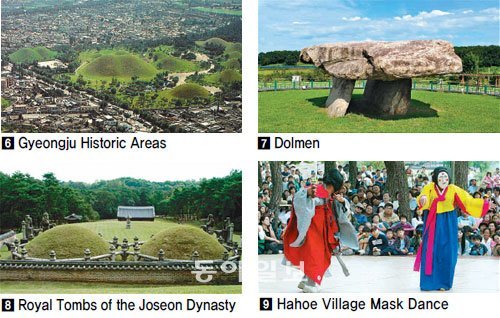
Gyeongju’s Historic Areas contain cultural relics including sculptures, reliefs, pagodas, and the remains of temples and palaces that date back to legendary Silla. The South Mountain area is scattered with Buddhist art, the Moon Fortress area contains the site of a palace and the Great Tumuli area is where the tombs of Silla kings and other royalty are concentrated. The Hwangnyongsa Temple area is a hub of Buddhist art, while the Mountain Fortress showcases Silla’s command of defensive architecture.
□7 Dolmen Sites
Prehistoric cemeteries in Gochang, Hwasun and Gangwha on Korea’s western coast contain dolmens - tombs constructed of large stone slabs during the Bronze Age. Artifacts, stoneware and earthenware have been found inside the dolmens.
There are about 30,000 dolmens in Korea - around half the number found worldwide. The dolmens in the three areas were built 2,000-3,000 years ago. They open windows onto Bronze Age life and death, and the beginnings of political power and economics.
□8 Royal Tombs of the Joseon Dynasty
Of the 42 royal tombs of Joseon dynasty kings and their consorts on the Korean peninsula, 40, excluding two in North Korea, have been named World Heritage properties. The Joseon royal tombs, which embody Korea’s Confucian tradition, retain their original forms and surroundings as they have been strictly managed and preserved since their founding.
□9 Hahoe and Yangdong Historic Villages
Hahoe village and Yangdong village, both in the southeast, are rare examples of villages that have preserved the traditional architecture and Confucian culture of the Joseon dynasty for more than 600 years. Clans that have lived there for generations are still in residence, and both villages boast intangible cultural assets such as the Hahoe mask dance, which exists here in its original forms. The villages are clusters of traditional Korean cottages, notable for their graceful curved roofs and enclosed courtyards.
UNESCO Natural World Heritage
□10 Jeju Volcanoes and Lava Caves
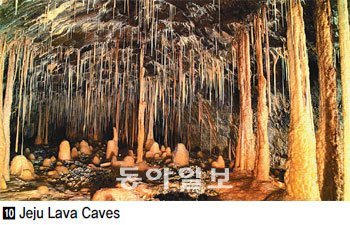
By Lee Kwang-pyo kplee@donga.com
-
- ???
- 0?
-
- ???
- 0?
-
- ???
- 0?
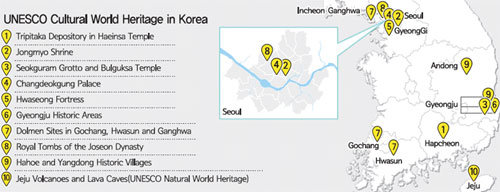
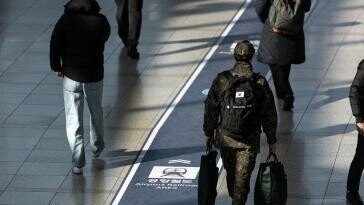
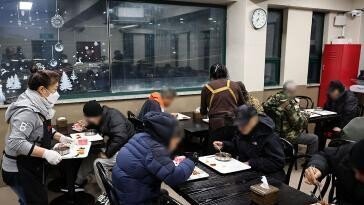
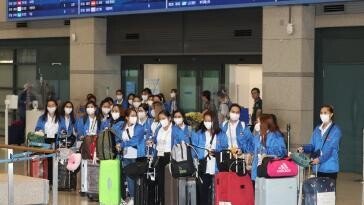
?? 0